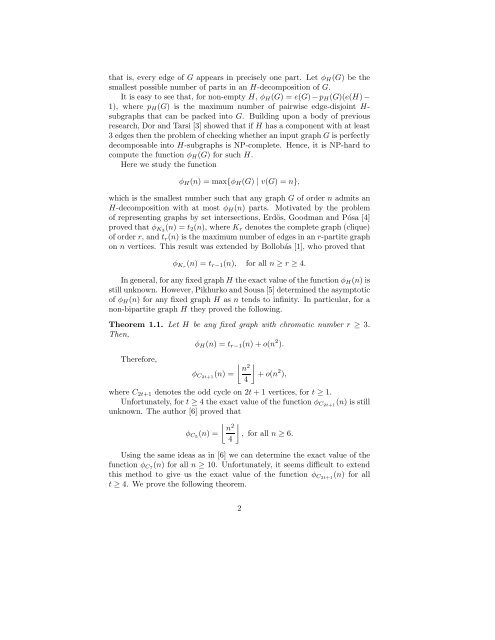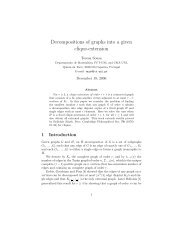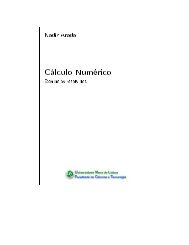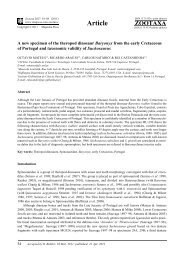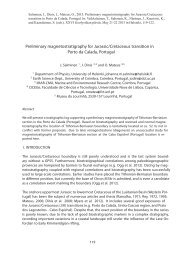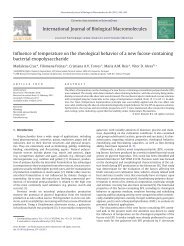Decomposition of graphs into cycles of length seven and single edges
Decomposition of graphs into cycles of length seven and single edges
Decomposition of graphs into cycles of length seven and single edges
Create successful ePaper yourself
Turn your PDF publications into a flip-book with our unique Google optimized e-Paper software.
that is, every edge <strong>of</strong> G appears in precisely one part. Let φH(G) bethe<br />
smallest possible number <strong>of</strong> parts in an H-decomposition <strong>of</strong> G.<br />
It is easy to see that, for non-empty H, φH(G) =e(G) − pH(G)(e(H) −<br />
1), where pH(G) is the maximum number <strong>of</strong> pairwise edge-disjoint Hsub<strong>graphs</strong><br />
that can be packed <strong>into</strong> G. Building upon a body <strong>of</strong> previous<br />
research, Dor <strong>and</strong> Tarsi [3] showed that if H has a component with at least<br />
3 <strong>edges</strong> then the problem <strong>of</strong> checking whether an input graph G is perfectly<br />
decomposable <strong>into</strong> H-sub<strong>graphs</strong> is NP-complete. Hence, it is NP-hard to<br />
compute the function φH(G) forsuchH.<br />
Here we study the function<br />
φH(n) =max{φH(G) | v(G) =n},<br />
which is the smallest number such that any graph G <strong>of</strong> order n admits an<br />
H-decomposition with at most φH(n) parts. Motivated by the problem<br />
<strong>of</strong> representing <strong>graphs</strong> by set intersections, Erdös, Goodman <strong>and</strong> Pósa [4]<br />
proved that φK3(n) =t2(n), where Kr denotes the complete graph (clique)<br />
<strong>of</strong> order r, <strong>and</strong>tr(n) is the maximum number <strong>of</strong> <strong>edges</strong> in an r-partite graph<br />
on n vertices. This result was extended by Bollobás [1], who proved that<br />
φKr(n) =tr−1(n), for all n ≥ r ≥ 4.<br />
In general, for any fixed graph H the exact value <strong>of</strong> the function φH(n)is<br />
still unknown. However, Pikhurko <strong>and</strong> Sousa [5] determined the asymptotic<br />
<strong>of</strong> φH(n) for any fixed graph H as n tends to infinity. In particular, for a<br />
non-bipartite graph H they proved the following.<br />
Theorem 1.1. Let H be any fixed graph with chromatic number r ≥ 3.<br />
Then,<br />
φH(n) =tr−1(n)+o(n 2 ).<br />
Therefore,<br />
2 n<br />
φC2t+1(n) = + o(n<br />
4<br />
2 ),<br />
where C2t+1 denotes the odd cycle on 2t + 1 vertices, for t ≥ 1.<br />
Unfortunately, for t ≥ 4 the exact value <strong>of</strong> the function φC2t+1(n) is still<br />
unknown. The author [6] proved that<br />
2 n<br />
φC5(n) = , for all n ≥ 6.<br />
4<br />
Using the same ideas as in [6] we can determine the exact value <strong>of</strong> the<br />
function φC7(n) for all n ≥ 10. Unfortunately, it seems difficult to extend<br />
this method to give us the exact value <strong>of</strong> the function φC2t+1(n) for all<br />
t ≥ 4. We prove the following theorem.<br />
2


